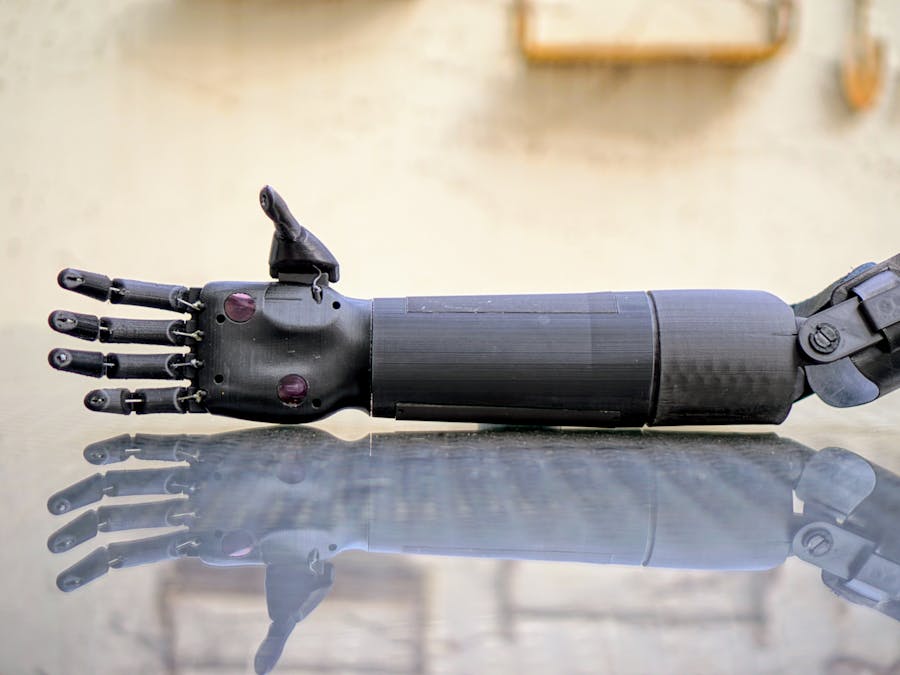Todos los archivos usados en este proyecto, incluyendo modelos de Inventor modificables y archivos STL para impresión, se pueden encontrar aquí.
Para información adicional, la página principal del proyecto es www.protesishighfive.cl
1. Descripción GeneralHigh Five consiste de una prótesis impresa en 3D con tecnología mioeléctrica para amputaciones transradiales. La medición de la actividad muscular en la remanencia de la extremidad, complementada con la posibilidad de personalización del funcionamiento con un sistema de lectura de tags RFID, permiten una solución más intuitiva y completa que las prótesis mecánicas tradicionales. Además, su capacidad de ser fabricada utilizando tecnología de impresión 3D junto con el libre acceso a sus modelos y esquemáticos permiten una solución de menor costo a los equipos comerciales de características similares.
1.1 Características y Funcionalidades- Dimensiones y peso de la prótesis comparables a su contraparte orgánica.
- Dedos de la prótesis pueden contraerse hasta 180 grados.
- Señales de control independientes entre dedos, para realización de diferentes posturas.
- Cada dedo es capaz de ejercer una fuerza de más de 15N, y tarda alrededor de 1s en contraerse completamente.
- Detección de actividad muscular de dos zonas musculares para accionamiento de la prótesis.
- Uso de electrodos metálicos secos reutilizables para la detección de las señales mioeléctricas, para ubicarse de manera sencilla sin requerir aplicación de gel conductivo.
- Feedback sensorial de la fuerza ejercida sobre la prótesis.
- Detección e identificación de tags RFID para personalizar el uso.
- Considerando el uso de un pack de baterías de 7000mAh, se tiene una duración de la alimentación de al menos 2 horas operando continuamente al nivel de consumo más alto. En condiciones nominales, la alimentación tiene una duración esperada del orden de 10 horas.
La placa controladora High Five es un sistema embebido para el control de los actuadores de la prótesis High Five. Genera las señales de control a partir de la lectura y procesamiento de señales analógicas provenientes de sensores mioeléctricos y la lectura e identificación de tags RFID. También integra divisores resistivos para la lectura de sensores de fuerza resistivos y señales de salida para motores con el objetivo de aplicar realimentación de la fuerza ejercida sobre la prótesis. Por último, la placa incluye pines de lectura adicionales, con el objetivo de promover el desarrollo de nuevas funcionalidades para la prótesis sin requerir una modificación del hardware.
Especificaciones:
- Microcontrolador: Atmega2560
- Salida control de actuadores lineales: 5 x 2 x PWM (6V / 500mA max.)
- Salida feedback de fuerza: 2 x PWM (3.0V)
- Lectura sensores mioeléctricos: 2 x ADC (0V -- 5.0V)
- Divisor resistivo para lectura de sensores de fuerza resistivos: 2 (10k ohms / 5.0V)
- Lectura desplazamiento actuador lineal: 5 x ADC (0V -- 5.0V)
- Comunicación: UART
- Pines adicionales: 4 x ADC (0V -- 5.0V)
- Voltaje de alimentación: > 7.5V
- Programación: ICSP (SPI)
- Tamaño: 101.6mm x 53.4mm
La placa High Five tiene también una variación que consiste en un shield para utilizar con una placa de desarrollo Arduino Mega. El fin de esta variación es permitir un debug más sencillo durante el desarrollo de nuevas funcionalidades a través de la programación más sencilla de la placa Arduino Mega y su interfaz serial incorporada, pese a que el hardware resulta menos compacto y con un consumo de potencia más elevado. El shield trae todas las funcionalidades de la placa estándar.
3. Instalación Circuito EléctricoSe presenta en las Figuras anteriores cómo deben conectarse los componentes a la placa controladora High Five y a la placa adaptadora para la mano.
La conexión entre las placas del controlador y la mano debe realizarse a través de un conector de cable plano. Un extremo de este cable debe soldarse a la placa de la mano como se indica en la segunda figura de abajo. El otro extremo debe conectarse a la placa controladora por medio de un conector IDC. Como guía, el pin superior izquierdo del conector a la mano en la primera figura de abajo. Esta debe quedar pareado con el pin superior derecho de la conexión al controlador en la figura de más abajo.
Por último, nótese cómo los conectores de los actuadores lineales deben insertarse con sus terminales hacia abajo, como se señala en la figura.
Las placas de detección de los sensores mioeléctricos deben ubicarse sobre la remanencia de la extremidad, en línea con el grupo muscular correspondiente. Los electrodos correspondientes al sensor M1 deben situarse sobre la cara interior del antebrazo mientras que los correspondientes al sensor M2 deben situarse sobre la cara exterior. La posición sobre la cual debe posicionarse cada placa puede encontrarse realizando la intención de contraer y extender la palma de la mano e identificando el centro del músculo correspondiente que se contrae. Es crítico para el buen funcionamiento de la prótesis que los electrodos se ubiquen correctamente. A modo de referencia, se presenta la figura.
Se detalla a continuación el proceso de ensamblaje de la prótesis. Como referencia, refiérase a la figura de ensamblaje, donde además se presenta la enumeración de los componentes utilizada en los pasos que siguen.
- Introduzca la placa controladora High Five (2) al antebrazo (1) de la prótesis y atorníllela a través de sus cuatro orificios. En caso de utilizar la versión como shield para Arduino de la placa High Five, introduzca primero la placa de desarrollo Arduino Mega y atorníllela al antebrazo. Luego conecte la placa High Five al Arduino Mega.
- Inserte el pulgar (4) de la prótesis y el resto de los dedos (5) en los zurcos de la mano (3).
- Ubique los cinco actuadores lineales (6) dentro de la mano de la prótesis.
- Para cada dedo, introduzca un cordel resistente a través de sus orificios, y amarre una punta del cordel al extremo de cada dedo y la otra al extremo del actuador lineal respectivo. Asegúrese que el cordel amarrado quede tenso al extenderse los dedos de la prótesis.
- Ubique la placa adaptadora (7) para la mano de la prótesis.
- Conecte los actuadores lineales, los sensores de fuerza resistivos y el lector RFID a la placa adaptadora de la mano.
- Cierre la mano de la prótesis con su tapa (8).
- Alinee el eje del soporte del antebrazo (9) con la banda para el brazo (10).
- Introduzca los pasadores (11) para el soporte y fíjelos en lugar con los seguros (12).
- Realice las conexiones eléctricas mencionadas previamente en la Sección 3, que incluyen la conexión de la placa adaptadora para la mano (a través del orificio del antebrazo), la conexión de los sensores mioeléctricos, los motores para feedback de fuerza, y la alimentación del controlador.
- Cierre el antebrazo de la prótesis con su tapa (13).
- Introduzca las baterías (14) en el compartimento posterior del antebrazo.
- Cierre el compartimento de las baterías con su tapa (15).
- Ensamble la mano (3), antebrazo (1) y soporte (9).
- Introduzca la remanencia de la extremidad al soporte del antebrazo de la prótesis. Afirme la prótesis ajustando la banda.
- Ubique los electrodos sobre los grupos musculares correspondientes del antebrazo como se indicó en la sección anterior.
- Encienda la prótesis activando el interruptor de alimentación.
- Se sugiere realizar una calibración del equipo cada vez que éste se use. Para ello siga la secuencia de calibración detallada más adelante.
- Los dedos de la prótesis se extienden activando los músculos exteriores del antebrazo (extensión de la muñeca) y contraen activando los músculos interiores del antebrazo (contracción de la muñeca). Ante contacto de la palma de la prótesis con algún objeto, se ejercerá una retroalimentación de la fuerza aplicada a través de vibración en el soporte del antebrazo.
- Si se acerca la palma de la prótesis a algún tag RFID asociado, la mano de la prótesis replicará una pose correspondiente y permanecerá en esta posición independiente de la actividad de los músculos del antebrazo. Para volver a controlar la prótesis a través de señales mioeléctricas, la palma de la prótesis debe acercarse a un tag RFID asociado a este modo de operación.
- Cuando termine de utilizar la prótesis, apáguela desactivando el interruptor de alimentación.
Secuencia de calibración:
- Extienda el brazo con la prótesis y mantenga los músculos del antebrazo en reposo.
- Conecte el terminal A10 de la placa controladora o shield al terminal 5V por medio de un interruptor o cable, manteniendo el antebrazo en reposo.
- Pasados unos segundos desconecte el terminal A10 del terminal 5V.
- Pruebe realizar el movimiento de extensión y contracción de la muñeca. Si la prótesis no responde, o se comporta de manera errática, se sugiere revisar el posicionamiento de los electrodos y luego repetir los pasos 3.1 a 3.3.
https://www.dfrobot.com/wiki/index.php/Analog_EMG_Sensor_by_OYMotion_SKU:SEN0240
https://openbionicslabs.com/obtutorials/muscle-control-v1-2
https://www.actuonix.com/Actuonix-PQ-12-P-Linear-Actuator-p/pq12-p.htm
http://www.id-innovations.com/httpdocs/ID-3LA,ID-12LA,ID-20LA.pdf





_wzec989qrF.jpg?auto=compress%2Cformat&w=48&h=48&fit=fill&bg=ffffff)



Comments